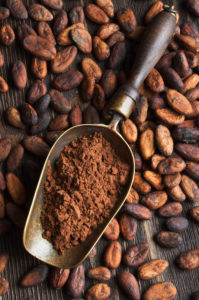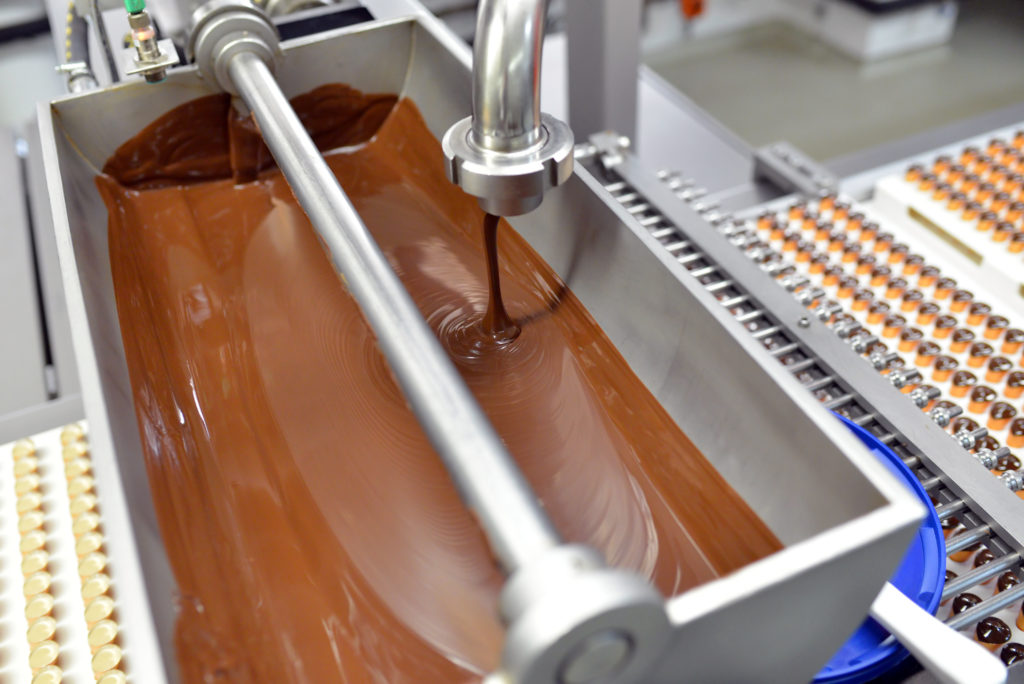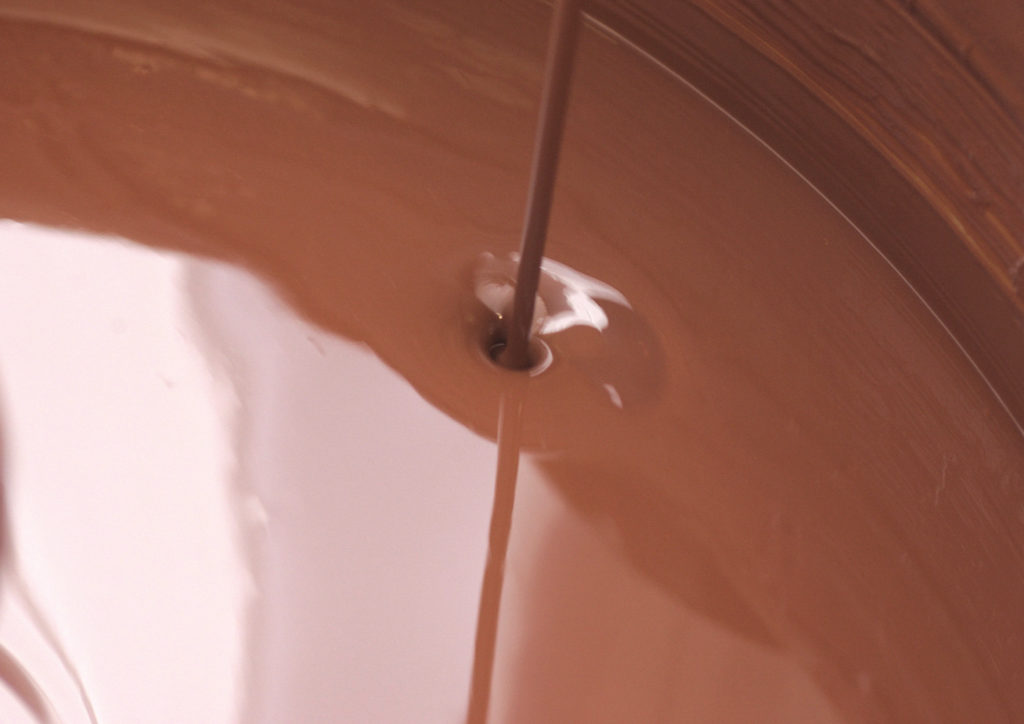This process reduces cocoa solids to the correct particle size and homogeneously distributes them, thanks to single-stage or double-stage systems or ball refiners. The resulting chocolate mass has pleasant notes on the palate
Plucking, fermentation, drying, roasting, refining, conching, tempering and molding: all these steps from the cabosse, the fruit of the cocoa tree (Theobroma cacao) lead to the production of chocolate. Each process, refining included, requires utmost accuracy, in order to obtain good quality chocolate.
Refining. The goal of this process consists in obtaining a chocolate with the correct texture, not gritty nor gummy. For this reason the granulometry should be somewhere around 25 microns, where the tongue loses its ability to determine the grittiness of particles. However, particles should not be too small, because the chocolate would get gummy. This defect may be corrected by adding greater quantities of cocoa butter in the later stages. Furthermore, a good refining process requires a uniform distribution of particles, with a fat content between 25 and 27%.

Refining systems. Refining systems used by chocolate factories use ball or roll refiners. Roll refiners consist of two/three or five smooth rollers, one above the other, although the most popular are those with five rollers. In the chocolate refining process, particles are crushed and fed through the counter-rotating granite or – more often – stainless steel rollers. Roll refining can occur in one or two stages. The use of crystal or powdered sugar has an impact on the refining process. In fact, if powdered sugar is used, refining can take place directly with the five-roll refiner in a single stage. On the other hand, with sugar crystals, i.e. with larger particles, the particle size must be reduced using a two- or three-stage refiner in a so-called pre-refining stage, followed by the final refining with a five-roller refiner. Pre-refining has two effects: the reduction of sugar particles size from 400 – 1,000 micron to 80 -120 micron, and the absorption of the fat fraction by other ingredients. The obtained chocolate paste will be more compact, and particles will have the correct size as required for final refining. Two-stage processes, comprising pre-refining and refining, proved to be more effective than one-stage processes. In fact, pre-refining gives optimum grain sizes to the chocolate mass that is fed to the final refining, resulting in a 10-20% increase in productivity and a far more homogeneous paste. Furthermore, the single-step process involves higher energy costs and more mixing time. As for the aroma, the chocolate obtained with two-step refining is better than that obtained without pre-refining, since powdered sugar can be the cause of a metallic after-taste, due to the grinding of sugar. The size of the ground particles depends on the distance between the rollers and the working surface, typically between 1 and 2.5 m. The lower roller, off-axis, feeds the chocolate mass to the other rollers, which are turning at a higher speed in order to pump the mass upwards while reducing the particle size at each pass. One of the fundamental keys to success in the refining process is the varying speed between the rollers, which influences the successful outcome of the refining process, just like the pressure they apply. The cold water flowing inside each roller contributes to reduce the temperature developed by the turning rollers and by their rubbing with cocoa particles, to approx. 25°C The temperature of the hollow rollers can be adjusted to reduce or increase the contact time between chocolate mass and rollers, and therefore the smoothness of the mass obtained at the end of the refining process. After having gone through the rollers, the chocolate mass is unloaded into several conches by scraping.
Manufacturers of refiners have to take into account that, due to their rotating speed, the rollers bend in the centre, and this might have a negative effect on the refining process. Therefore, rollers are provided with a pre-deformation (i.e. an arched edge), accurately gauged to obtain the desired particle size. Scrapers are easily dismountable, for accurate cleaning, and a special device provides for their perfect adherence to the rollers in any position. Refiners equipped with powerful engines convey more power to the process, thus providing for reduced processing times and extremely fine particles. Most refiners feature sound-proofing, in order to reduce noise emissions typical of this kind of process. Furthermore, the refining rollers can be adjusted and in order to compensate any irregular wear of the parts after year of work. Other parameters can be adjusted, either automatically via PLC or manually, according to the type of chocolate to be obtained. Refining systems are regulated based on different parameters like roller temperature, number of rotations of the lowest roller, pressure between the rollers, and the intensity of the power line that feeds the motors. Several technical novelties are built to provide greater precision and reliability of the refiner, as well as improved accessibility for inspection and cleaning, significant reduction of maintenance efforts due to improved positioning of the refining rollers. Chocolate refining is possible not only with roller refiners but also with ball refiners, made in high-strength steel, which can be used for recipes with a fat content of even 30%. The fineness obtained can range between 20 and 22 micron, and is ideal for products like creams, spreads, glazing, chocolate substitute, hazelnut paste. These refiners are more cost-effective and versatile, but can process smaller amounts of material (25 to 500 kg). They can work in batch or continuous mode. The ingredients are poured into the pre-mixing tank; several recipes are handled by dedicated software with simple adjustment of a few parameters, like refining time and temperature, and/or dosing of ingredients. The refining takes place with a stirring shaft and arms and tempered steel balls that rotate in the double-walled grinding tank. The refining units move in the same direction, but at different speeds. This means that the speed of the balls at the ends of the arms is higher than the speed of the balls on the outer portion of the tank. This contributes to reduce the rubbing between the balls and the walls of the tank, thus reducing also the wearing of the parts. In this case cooling does not take place with water, but is obtained thanks to the continuously new amount of chocolate mass that runs along the cooling wall. Electronic control of product heating and cooling; control of the number of revolutions in compliance with motor absorption, with relevant automatic reduction of the speed upon increasing product density, are directed to better preserve the texture and taste of the product leaving the refiner. In some cases, both refining techniques can be combined to achieve higher fineness for all types of chocolate or creams. In this case, refining is carried out by three units: one double-roller refiner, one five-roller refiner and one ball refiner. The mixed chocolate mass reaches the hopper and is fed into the double-roller refiner; than a screw transfers it to the vertical roller refiner. A pump feeds the product to the last ball refiner; after that the product goes through a filter and is fed to the conching unit. The parameters influencing refining, such as pressure and correct temperature, are electronically controlled via PLC, with control panel with touch-screen, for full control of the line.
Energy consumption: it depends on the rotation speed and on the mass of balls A group of Serbian researchers (Fišteš et al., 2013) investigated the effects of main milling variables on power requirements and energy consumption of a ball refiner, by changing the agitator shaft speed and the number of balls. Results showed that by increasing the agitator speed even the energy consumption of the machine increases. Whereas, by keeping a minimum speed (10%) and increasing the mass of balls, no energy increase is registered for a weight increase of the balls from 30 to 40 kg; it significantly increases if the mass changes from 20 to 30 kg in the retention time comprised between 20 and 70%. For agitator values equal or higher than 80%, power requirements become more noticeable with increased mass of the steel balls. The study focused on energy consumption related to different agitator shaft speeds and different mass of the steel balls, but did not take into account the quality of the refined chocolate mass depending on these parameters.






[…] alcuni articoli: Fresh pasta, versatility and automation for a high-quality product; Refining systems, a delicate operation; Manufacture of oligosaccharides from vine shoots by bio-refinery […]
Comments are closed.